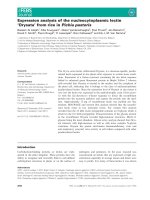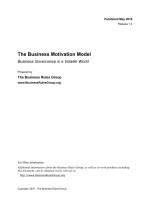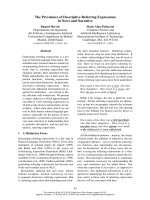The Benefits to Taxpayers from Increases in Students'''' Educational Attainment pot
Bạn đang xem bản rút gọn của tài liệu. Xem và tải ngay bản đầy đủ của tài liệu tại đây (961.7 KB, 143 trang )
This document and trademark(s) contained herein are protected by law as indicated in a
notice appearing later in this work. This electronic representation of RAND intellectual
property is provided for non-commercial use only. Unauthorized posting of RAND PDFs
to a non-RAND Web site is prohibited. RAND PDFs are protected under copyright law.
Permission is required from RAND to reproduce, or reuse in another form, any of our research
documents for commercial use. For information on reprint and linking permissions, please
see RAND Permissions.
Limited Electronic Distribution Rights
Visit RAND at www.rand.org
Explore RAND Education
View document details
For More Information
Purchase this document
Browse Books & Publications
Make a charitable contribution
Support RAND
This PDF document was made available from www.rand.org as
a public service of the RAND Corporation.
6
Jump down to document
The RAND Corporation is a nonprofit research
organization providing objective analysis and
effective solutions that address the challenges facing
the public and private sectors around the world.
THE ARTS
CHILD POLICY
CIVIL JUSTICE
EDUCATION
ENERGY AND ENVIRONMENT
HEALTH AND HEALTH CARE
INTERNATIONAL AFFAIRS
NATIONAL SECURITY
POPULATION AND AGING
PUBLIC SAFETY
SCIENCE AND TECHNOLOGY
SUBSTANCE ABUSE
TERRORISM AND
HOMELAND SECURITY
TRANSPORTATION AND
INFRASTRUCTURE
WORKFORCE AND WORKPLACE
This product is part of the RAND Corporation monograph series. RAND
monographs present major research findings that address the challenges facing
the public and private sectors. All RAND monographs undergo rigorous peer
review to ensure high standards for research quality and objectivity.
The Benefits to Taxpayers
from Increases in Students’
Educational Attainment
Stephen J. Carroll, Emre Erkut
EDUCATION
Supported by the The William and Flora Hewlett Foundation
The RAND Corporation is a nonprofit research organization providing
objective analysis and effective solutions that address the challenges
facing the public and private sectors around the world. R AND’s
publications do not necessarily reflect the opinions of its research clients
and sponsors.
R
®
is a registered trademark.
© Copyright 2009 RAND Corporation
Permission is given to duplicate this document for personal use only, as
long as it is unaltered and complete. Copies may not be duplicated for
commercial purposes. Unauthorized posting of RAND documents to
a non-RAND Web site is prohibited. RAND documents are protected
under copyright law. For information on reprint and linking permissions,
please visit the RAND permissions page ( />publications/permissions.html).
Published 2009 by the RAND Corporation
1776 Main Street, P.O. Box 2138, Santa Monica, CA 90407-2138
1200 South Hayes Street, Arlington, VA 22202-5050
4570 Fifth Avenue, Suite 600, Pittsburgh, PA 15213-2665
RAND URL:
To order RAND documents or to obtain additional information, contact
Distribution Services: Telephone: (310) 451-7002;
Fax: (310) 451-6915; Email:
The research in this report was produced within RAND Education, a
unit of the RAND Corporation, with support from the William and
Flora Hewlett Foundation.
Library of Congress Cataloging-in-Publication Data
Carroll, Stephen J., 1940–
The benefits to taxpayers from increases in students’ educational attainment /
Stephen J. Carroll, Emre Erkut.
p. cm.
Includes bibliographical references.
ISBN 978-0-8330-4742-7 (pbk. : alk. paper)
1. Public schools—United States—Finance. 2. Education—United States—
Finance. 3. Income tax—United States. I. Erkut, Emre. II. Title.
LB2825.C315 2009
379.1'10973—dc22
2009024776
iii
Preface
Meeting the educational demands of the future will be expensive; however, in most
states, public schools from kindergarten through the university level already experi-
ence budgetary challenges. Policymakers face a fundamental challenge—motivating
taxpayers to provide the funds needed to meet mounting education needs.
is report examines the financial benefits that taxpayers realize when students’
educational attainment is increased. We find that the benefits to taxpayers from increases
in students’ educational attainment are very high. Regardless of a student’s gender or
race/ethnicity, raising his or her level of education leads, on average, to substantially
increased payments into, and reduced demands on, the public budget. We consider
the cost of providing additional education to students, although we do not explore the
question of what it would cost to motivate students to stay longer in school. Our analy-
sis indicates that taxpayers accrue benefits from programs and policies that succeed
in raising students’ education levels, and those benefits are entirely separate from the
benefits that the students themselves gain through increased education. Accordingly,
taxpayers, including those who do not have children in school, have a stake in develop-
ing programs and policies that effectively and efficiently increase education levels.
is report’s findings should be of interest to a broad range of policymakers,
researchers, administrators, teachers, and parents.
is research was conducted within RAND Education, a division of the RAND
Corporation, with support from the William and Flora Hewlett Foundation.
v
Contents
Preface iii
Figures
ix
Tables
xi
Summary
xiii
Acknowledgments
xxi
Abbreviations
xxiii
CHAPTER ONE
Introduction 1
e Problem
1
Research Objective
2
e Costs of Providing Education Versus the Overall Costs of Increasing
Educational Attainment
2
Research Questions
3
Illustrative Examples
5
Previous Research
7
Definition of Terms
9
Organization of the Report
10
CHAPTER TWO
Analytic Approach 13
Independent Variables
13
Education and Earnings
14
Tax Payments
18
Federal Income Taxes
18
State and Local Taxes
19
Payroll Taxes
19
Social Program Participation and Costs
19
Incarceration Costs
21
Estimating the Effects of Increased Education
22
Transformations
24
vi The Benefits to Taxpayers from Increases in Students’ Educational Attainment
Critical Assumptions 25
Putting the Results in Perspective
27
CHAPTER THREE
Payments for Taxes and Social Programs 29
Taxation Mechanisms
29
Educational Attainment and Earnings
31
Federal and State Tax Rates
32
Federal Income Tax Rates
32
Payroll Tax Rates
33
Average State Tax Rates
34
e Effects of Increased Educational Attainment on Tax Payments
34
Related Studies
36
e Effects of Multilevel Increases in Educational Attainment on Tax Payments
37
Sensitivity Analysis
37
Summary
39
CHAPTER FOUR
Spending on Social Support Programs 41
Background
41
Analytic Approach
42
Effects of Educational Attainment on the Costs of Welfare Programs
44
Effects of Educational Attainment on the Costs of Housing Subsidies
46
Effects of Educational Attainment on the Costs of Food Stamps
47
Effects of Educational Attainment on Supplemental Security Income Spending
49
Effects of Educational Attainment on Medicaid Spending
50
Effects of Educational Attainment on Medicare Spending
52
Effects of Educational Attainment on the Costs of Unemployment Insurance
53
Effects of Educational Attainment on Social Security Spending
55
Effects of Educational Attainment on Spending on Social Programs
56
Sensitivity Analysis
58
Summary
60
CHAPTER FIVE
Educational Attainment and Spending on the Corrections System 61
Analytic Approach
62
e Effect of Educational Attainment on Crime Rates
63
Effects of Educational Attainment on Incarceration Costs
65
Sensitivity Analysis
67
Summary
68
Contents vii
CHAPTER SIX
e Costs of Providing Additional Education 69
CHAPTER SEVEN
Educational Attainment and Public Revenues and Costs 73
Effects of Increases in Education on the Public Budget
73
Tax Payments
73
Spending on Social Support and Insurance Programs
74
Incarceration Costs
74
Costs of Increased Education
75
Net Benefits from Increased Educational Attainment
75
e Effects of Increased Educational Attainment: An Example
80
Sensitivity Analysis
82
Putting the Estimates in Perspective
84
Summary
85
APPENDIXES
A. Data and Sources 87
B. Estimating Tax Payments
91
C. Social Program Participation and Costs
95
D. Incarceration Cost Estimations
111
References
113
ix
Figures
3.1. Present Value of Lifetime Increases in Tax Payments Resulting from
Increased Education, U.S Born Men
35
3.2. Present Value of Lifetime Increases in Tax Payments Resulting from
Increased Educational Attainment, U.S Born Women
36
4.1. Expected Annual Welfare Program Spending for a U.S Born Hispanic
Woman
45
4.2. Expected Annual Public Housing Subsidies for a U.S Born Hispanic
Woman
47
4.3. Expected Annual Food Stamp Benefits for a U.S Born Hispanic Woman
48
4.4. Expected Annual Supplemental Security Income for a U.S Born Hispanic
Woman
50
4.5. Expected Annual Medicaid Benefits for a U.S Born Hispanic Woman
51
4.6. Expected Annual Medicare Benefits for a U.S Born Hispanic Woman
53
4.7. Expected Annual Unemployment Compensation for a U.S Born Hispanic
Woman
54
4.8. Expected Annual Social Security Benefits for a U.S Born Hispanic
Woman
56
4.9. 2002 Value of Lifetime Decrease in Social Program Spending Resulting
from Increased Education for U.S Born Men
57
4.10. 2002 Value of Lifetime Decrease in Social Program Spending Resulting
from Increased Education for U.S Born Women
58
5.1. 2002 Value of Lifetime Decrease in Incarceration Spending Resulting
from Increased Education for U.S Born Men
66
5.2. 2002 Value of Lifetime Decrease in Incarceration Spending Resulting
from Increased Education for U.S Born Women
67
7.1. Benefits and Costs of Raising the Education of a U.S Born Hispanic
Woman from Less an High School Graduate to College Graduate
81
xi
Tables
2.1. Ratio of Median Usual Weekly Earnings of Full-time Wage and Salary
Workers 25 Years and Over, by Educational Attainment
16
2.2. Percentage of Persons Age 25 to 64 Who Are Employed, by
Race/Ethnicity, Gender, and Education Level, 1992–2007
17
3.1a. Average 2002 Individual Annual Earnings, by Ethnicity and Education
Level
32
3.1b. Average 2002 Family Annual Income, by Ethnicity and Education Level
32
3.2. Average Federal Income Tax Rates and Related Data, by Income
33
3.3. Statutory 2002 Payroll Tax Rates and Medicare Tax Cap
33
3.4. State and Local Tax Rates for 2002, U.S. Average
34
3.5. Increased Tax Payments Associated with Increasing Educational
Attainment from High School Dropout to College Graduate,
U.S Born Men and Women
38
3.6. Range of Percentage Reduction in Tax Payments If the Effect of Increased
Education Is Reduced 25 Percent, U.S Born Men and Women
38
3.7. Smallest Estimated Effect of Increased Education on Tax Payments If
Effect of Increased Education Is Reduced 25 Percent, U.S Born Men
and Women
39
4.1. Medicare and Medicaid Benefit Estimates, 2002
44
4.2. Range of Percentage Reduction in Social Program Spending If Effect of
Increased Education Is Reduced 25 Percent, U.S Born Men and Women
59
4.3. Smallest Estimated Effect of Increased Education on Reduction in Social
Program Spending If Effect of Increased Education Is Reduced 25 Percent,
U.S Born Men and Women
59
5.1. Educational Attainment for Inmates and the General Population
61
5.2. Total and Unit Costs of Incarceration, 2002
62
5.3. Present Value of Reduced Spending on Incarceration Associated with
Increasing Educational Attainment from High School Dropout to College
Graduate for U.S Born Individuals
68
7.1. Effects of Increasing Education from High School Dropout to High School
Graduate on Public Revenues and Costs for a U.S Born White Male
76
xii The Benefits to Taxpayers from Increases in Students’ Educational Attainment
7.2. Benefits to Taxpayers from Increasing Educational Attainment from
Less an High School to High School Graduate, U.S Born Men
and Women
77
7.3. Benefits to Taxpayers from Increasing Educational Attainment from
High School Graduate to Some College, U.S Born Men and Women
78
7.4 . Benefits to Taxpayers from Increasing Educational Attainment from
Some College to College Graduate, U.S Born Men and Women
79
7.5. Benefits to Taxpayers from Increasing Educational Attainment from
High School Dropout to College Graduate, U.S Born Men and Women
80
7.6. Net Benefits from Increased Educational Attainment Among U.S Born
Hispanics
82
7.7. Range of Percentage Reduction in Net Benefits to Taxpayers If the Effect
of Increased Education Is Reduced 25 Percent
82
7.8. Smallest Estimated Effect of Increased Education on Net Benefits If Effect
of Increased Education Is Reduced
83
B.1. Estimated Two-Part Model of 2002 Payroll Tax Payments
92
B.2. Estimates of 2002 Federal and State Tax Payments
94
C.1. Estimated Two-Part Model of 2002 Welfare Income
(Temporary Assistance to Needy Families, General Assistance, Other)
98
C.2. Estimates of 2002 Subsidized Housing Participation
99
C.3. Estimated Two-Part Model of 2002 Food Stamp Income
101
C.4a. Estimated Two-Part Model of 2002 SSI Income
102
C.4b. Estimated Two-Part Model of 2002 SSI Income
103
C.5. Estimates of 2002 Medicaid Participation
105
C.6. Estimates of 2002 Medicare Participation
106
C.7. Estimated Two-Part Model of 2002 Unemployment Insurance
Income
108
C.8a. Estimated Two-Part Model of 2002 Social Security Income
109
C.8b. Estimated Two-Part Model of 2002 Social Security Income
110
xiii
Summary
Policymakers in most states face a fundamental challenge—motivating taxpayers to
provide the funds required to meet mounting educational needs. e level of education
needed to succeed in labor markets and support economic growth is increasing rap-
idly. But, in most states, public schools from kindergarten through the university level
already face budgetary limits, and meeting the demands of the future will be expen-
sive. Taxpayers who do not have children in public school frequently question why they
should contribute more to the support of educational institutions, or why those who
stand to benefit the most—the students—should not pay more for their education.
In this study, we explore the financial benefits that taxpayers enjoy as a result of
increases in students’ education levels. We specifically address three research questions:
How do increases in an individual’s educational attainment affect
tax revenues•
program expenditures and revenues for a range of social support and insurance •
programs
spending for prisons and jails?•
We then subtract the costs of providing additional education to a student from the
estimated effects of an increase in his or her education level on public spending and
revenues to estimate the net benefit to taxpayers resulting from the increase in an indi-
vidual’s education.
Our findings indicate that an increase in a student’s educational attainment—
say, completing high school rather than dropping out—results in substantial benefits
to taxpayers over time. For example, if a U.S born, Hispanic man who would have
dropped out of high school were to obtain a high school diploma instead, the dis-
counted present value of the net benefits to taxpayers equals about $87,000 in 2002
dollars. e comparable result for a U.S born, Hispanic woman is almost as large,
with net benefits equal to about $83,000 in 2002 dollars. e results for other racial
and ethnic groups are similar.
Our analysis focuses on the net benefits to taxpayers from increases in educational
attainment. However, this is not a cost-benefit analysis of specific programs, since we
xiv The Benefits to Taxpayers from Increases in Students’ Educational Attainment
do not consider the costs of developing and operating programs and policies aimed at
encouraging students to pursue higher education levels. Consequently, we do not know
how the benefits from increases in education levels to taxpayers compare with the costs
of policies and programs that induce students to increase their education. Our objec-
tive is to demonstrate that taxpayers gain certain benefits from programs and policies
that result in greater educational attainment, even if the taxpayers do not have children
in school, and that taxpayers should consequently consider these benefits in assessing
the importance of developing and implementing programs and policies to increase
education levels.
Analytic Approach
To address the research questions, we estimate the extent to which increased educa-
tional attainment will result in three types of benefits to taxpayers:
increases in federal, state, and local tax revenues and increases in contributions to •
social support and insurance programs, such as Social Security and Medicare
reductions in public expenditures on social support and insurance programs•
reductions in public expenditures on incarceration—the costs of operating state •
prisons and county and municipal jails.
By “increased educational attainment,” we mean more time in school, rather than
“better” education in the sense of the schools doing a better job. Similarly, when we
talk about additional spending on education, we mean the spending required to serve
individuals in school longer; we do not consider the costs of programs aimed at induc-
ing students to remain in school longer.
We use a nationally representative sample of roughly 40,000 individuals covered
in all months of 2002 by the Survey of Income and Program Participation (SIPP) to
model the effects of education level (some high school, high school graduation, some
college, and college graduation) on public revenues and expenditures, depending on an
individual’s age, gender, and race/ethnicity—African-American (black), Asian, His-
panic, Native American, or non-Hispanic white (white).
We estimate the effects of education level on federal, state, and local tax payments
and payments into social support and insurance programs throughout the entire work-
ing life of an adult, using appropriate survival rates. We use federal data to estimate
payments of federal taxes and contributions to social support and insurance programs,
such as Social Security and Medicare. State and local tax schedules vary across the
country, so we use U.S. national average state and local tax schedules to estimate state
and local tax payments.
Summary xv
We examine the effects of education level on program spending for eight of the
country’s largest social support and insurance programs for which sufficient data on
program participation and program spending are available. Different segments of the
population participate at different rates in social support and insurance programs.
Consequently, we conduct separate analyses for different groups distinguished by
gender and race/ethnicity. Because the social programs we examine are all national
programs, we use the national sample to model the effects of educational attainment
on (1) the likelihood that a person will enroll in a social support or insurance program
and (2) the amount of benefit that a person will receive from a social support program
upon enrollment.
Incarceration rates and the costs of operating prisons and jails vary across the
country. Because federal prisons house a small percentage of prisoners, we focus on
the effects of education on the costs of operating state prisons and local jails. We use
U.S. national average data to estimate the effects of education level on the probability
of incarceration in state prisons or in county and municipal jails for each combina-
tion of age, race/ethnicity, and gender. We use the national average cost per inmate of
operating state prison system and county and municipal jails to estimate the effects of
increased educational attainment on the costs of incarceration.
We use national average operating cost estimates for public secondary and post-
secondary education systems to estimate the costs of providing additional education.
We assume that the costs of providing additional education to a student equal the
national average operating costs per student at each level of education. We subtract the
costs of providing additional education from the resulting benefits to estimate the net
benefits to taxpayers from increased educational attainment.
Because the benefits to taxpayers of additional education are spread over an indi-
vidual’s lifetime—as he or she pays more in taxes, places fewer demands on social sup-
port programs, and does not engender incarceration costs—we estimate the expected
effects of increased education over each year of an individual’s lifetime and then dis-
count the annual benefits to calculate their current values at age 18. Because much of
our data are for 2002, we discount all dollar amounts to 2002 dollars, at an annual rate
of 3 percent. We then estimate the net benefit of increased educational attainment to
taxpayers in 2002 dollars.
Because of data limitations in the SIPP, it is not possible to estimate similar effects
for immigrants—those young enough to obtain additional U.S based education at the
high school or postsecondary level—as for the native-born. For that reason, we focus
our report on results for U.S born individuals. However, we did include immigrants
in our sample and estimated models to differentiate between native- and foreign-born
individuals. While not definitive, estimates for immigrants comparable to those we
present here for the native-born suggest that the benefits from increased education for
immigrants will be of a similar order of magnitude.
xvi The Benefits to Taxpayers from Increases in Students’ Educational Attainment
Payments for Taxes and Social Support and Insurance Programs
Greater educational attainment increases the likelihood that an individual will be
employed and the level of his or her wages or salary when employed. e available evi-
dence strongly indicates that more education increases an employed person’s earnings
capacity (their wage when employed) by at least 7 to 10 percent per additional year
of schooling. e higher earnings realized by more highly educated people result in
higher tax payments and higher payments to social support and insurance programs.
We model tax and social support and insurance payments as a function of educa-
tion level, age, and demographic characteristics. For every population group, increases
in an individual’s education level result in substantial increases in payments into tax and
social support and insurance programs. Graduating from college rather than ending
schooling with some college provides the largest impact on tax payments, followed by
obtaining a high school diploma rather than dropping out of high school. e differ-
ence between the tax payments made by a person with a high school diploma and an
otherwise similar person with some college is smaller, but still substantial.
e effects of increases in education on tax and social insurance payments are
generally greater for men than for women at all education levels and in all race/ethnic
groups.
Spending for Social Support and Insurance Programs
Because an increase in educational attainment increases both the likelihood of employ-
ment and an individual’s wages when employed, it reduces the likelihood that the indi-
vidual will participate in social support programs. e higher earnings resulting from
greater educational attainment also reduce the amount that a more highly educated
person collects when he or she does participate in most social support programs.
Analyses focused on the benefits of increased education to students or to society
as a whole generally view public assistance costs as transfer payments. From this per-
spective, reductions in social support payments resulting from increases in educational
attainment simply reduce transfers from taxpayers to social support program partici-
pants, with no benefits to society as a whole except for reductions in the administrative
costs of social support programs. But, from the perspective of taxpayers, who provide
the funds that social support programs distribute to participants, reductions in the
costs of social support programs resulting from increased education are a benefit.
We model participation in each of eight social support programs as a function
of education level, age, and demographic characteristics. Except for Unemployment
Insurance and Social Security, increases in an individual’s education level result in
substantial reductions in the likelihood of participation and in benefits paid when
the individual participates. Unemployment Insurance is an exception in that the level
Summary xvii
of compensation received depends on the person’s last salary, which in turn depends
on that person’s level of education. Social Security is an exception in that the retire-
ment compensation received under the retirement subprogram depends on the person’s
cumulative contribution during the entire time he or she spent in the work force, which
in turn is highly sensitive to that individual’s level of education.
e greatest reductions in spending on social support programs result from grad-
uating from high school rather than dropping out. Beyond the high school diploma,
some college has a greater impact for women and a college degree has greater impact
for men.
Spending for Prisons and Jails
Research strongly demonstrates that education reduces the likelihood that an individ-
ual will engage in criminal activity. Increases in educational attainment consequently
reduce the likelihood that an individual will be incarcerated. Reductions in the size of
the prison and jail population decrease the costs of operating and maintaining correc-
tional facilities. Because federal prisons hold a small share of inmates and account for
a small fraction of nationwide incarceration, we concentrate on the savings that would
be achieved on spending for state prisons and county and municipal jails.
Analyses of the effects of increased education on the costs of the criminal justice
system often account not only for incarceration costs but also the other criminal justice
system costs, such as police and adjudication. Because of resource limitation, we lim-
ited our analysis to the effects of increased education on incarceration costs.
Increases in educational attainment yield the greatest savings in incarceration
costs among those who graduate from high school rather than dropping out. e sav-
ings to the public budget are less from those who have some college education rather
than none, and rather little from those who graduate from college compared to settling
for some college. Even for the highest-risk population subgroups of black and Hispanic
men, a bachelor’s degree results in just a small increase in incarceration savings com-
pared with entering but not graduating college.
For both men and women, the primary savings on the costs of incarceration result
from increased education within the black population. For each race/ethnicity group,
the magnitude of savings within each female group is generally about one-tenth of that
in the corresponding male group.
The Cost of Additional Education
Increasing educational attainment requires higher spending to provide the additional
education. Our estimates are based on U.S. national average costs of public education.
xviii The Benefits to Taxpayers from Increases in Students’ Educational Attainment
In the 2001–2002 school year, the closest corresponding school year to the calendar
year 2002, in which our data were collected, the national average current expenditure
per student in average daily attendance (ADA) in public K–12 education was about
$7,700. at school year, it cost taxpayers about $7,600 per full-time equivalent (FTE)
student to provide additional education in a public two-year college and about $10,000
per FTE to provide additional education in a public four-year college or university.
ese are the additional costs of providing additional education. ey do not
include the costs of programs and policies aimed at motivating students to obtain addi-
tional education.
Net Benefits to Taxpayers
e net benefits to taxpayers of increased educational attainment equal the sum of
the increases in public revenues and the reductions in public spending resulting from
increased education minus the cost of providing the additional education.
To illustrate the calculations: On average, increasing a U.S born, white man’s
educational attainment from less than high school graduation to high school gradu-
ation would result in increased tax payments over his lifetime equal to $54,000. (All
the figures in this paragraph are presented in 2002 dollars, in discounted present value
to age 18). e increase in his education level would also result in reduced future
demands on social support programs and reduced future incarceration costs equal to
about $22,000 and $13,000, respectively. us, the average total public benefits of
increasing a U.S born, white male’s education level from less than high school to high
school graduate would equal about $89,000. Providing the additional education would
cost about $15,000, so the net benefit to taxpayers would be about $74,000. In sum, if
a U.S born, white male who would drop out of high school were to instead graduate
high school, taxpayers would realize net benefits equal, in discounted present value, to
about $74,000.
e benefits to taxpayers from increased educational attainment clearly exceed
the costs of providing the additional education by a large margin for the members of
every population group. Regardless of a student’s gender or race/ethnicity, raising the
level of education he or she attains creates high net benefits for the public budget.
Again, we note that these results pertain to the net benefits to taxpayers of
increases in students’ educational attainment. We do not consider the costs of develop-
ing and operating programs and policies aimed at inducing students to pursue higher
education levels.
Summary xix
Sensitivity Analyses
To test how sensitive our results are to our estimates of the effects of increases in edu-
cation level, we recalculated the benefits to taxpayers from an increase in education
for each demographic group assuming that the effects of increases in education on tax
payments, social program costs, and incarceration costs were each 25 percent smaller
than our original estimate. Reducing the estimated effect of increasing education from
less than high school to high school graduate by 25 percent resulted in a reduction in
the discounted present value of lifetime net benefits to taxpayers of 28 to 34 percent,
depending on the demographic group, for U.S born men and women. e results of
similar sensitivity analyses for the effects of increasing education from high school
graduate to some college and for the effect of increasing education from some college
to college graduate were very similar.
e present value of net benefits to taxpayers from an increase in education are
substantial even if we assume the effects of education on public revenues and costs are
25 percent smaller than our estimates. We estimate that the benefit to taxpayers from
increasing an individual’s education from less than high school to high school gradu-
ate is at least $51,000 (present value, net of the cost of providing the additional educa-
tion) for each U.S born demographic group. If we assume that the effect of increasing
education from high school graduate to some college is 25 percent smaller than our
estimate, the benefit to taxpayers is still at least $24,000 (present value, net of the cost
of providing the additional education), depending on the demographic group. For the
increase in education from some college to college graduate, the benefit to taxpayers,
assuming a 25-percent-smaller effect of education level, is at least $53,000 (present
value, net of the cost of providing the additional education), depending on the demo-
graphic group.
Putting the Results in Perspective
As noted previously, we use data collected in 2002 to estimate the models used in this
analysis. In doing so, we assume that the estimated relationships between education
level and governmental revenues and costs will remain approximately the same into
the future. Specifically, we assume that the effects of education on earnings and, con-
sequently, on tax payments and participation in social programs, in the future will be
essentially the same as the effects observed in 2002. We also assume that federal, state,
and local tax structures, social support programs, and incarceration patterns will not
change substantially in the future.
Changes in some of these relationships are likely to occur at some future date.
Consequently, the estimates presented here cannot be viewed as precise. However, the
magnitudes of the estimates are generally so large that, even if changes in these rela-
xx The Benefits to Taxpayers from Increases in Students’ Educational Attainment
tionships substantially reduce the effects of increased educational attainment on gov-
ernment revenues and costs, the net benefits to taxpayers will still be substantial. More-
over, changes that increase the effects of education level on government revenues and
costs are more likely than are changes that reduce the effects. If such changes occur, the
estimates presented here will understate the effects of increased educational attainment
on government revenues and costs.
Our analysis assumes that the relationships observed in the data are causal. at
is, we assume that the differences in contributions to government revenues and costs
between more highly educated and less highly educated people are the result of the
differences in their levels of education. ere is abundant evidence that increased edu-
cational attainment leads to increases in earnings and that earnings are related to con-
tributions to government revenues and costs. It is possible that some other factor is
related to both the level of an individual’s education and his or her contributions to
government revenues and costs. But it is clear that education is a dominant factor, even
if there are others. Moreover, the magnitude of the effect of education on earnings has
grown consistently over time. Because we assume that the relationships between edu-
cational attainment and contributions to government revenues and costs that existed
in 2002 will continue over time, our estimates do not reflect the effects of increases
in the effect of educational attainment on earnings and, consequently, on government
revenues and costs.
e bottom line is that these estimates, notwithstanding the inherent uncertain-
ties in estimating future trends and patterns, show that increased educational attain-
ment yields significant benefits to taxpayers. We recognize that the greatest gains accrue
to those whose education levels are improved and that increases in educational attain-
ment also provide numerous types of noneconomic benefits in addition to economic
benefits. However, this analysis indicates that raising an individual’s level of education
creates high benefits for the public budget, benefits that should be considered in assess-
ing the importance of finding, funding, and implementing programs aimed at increas-
ing educational attainment.
xxi
Acknowledgments
We are indebted to several RAND colleagues who contributed to this study. Richard
Neu, J. R. Lockwood, and Lynn Karoly reviewed earlier drafts of this report. eir
insightful comments and suggestions provided significant contributions to this analy-
sis. We also thank Shelley Wiseman for helping us with the structure and clarity of this
report, Nancy Good and Christopher Dirks for helping with the preparation of this
report, and James Torr, whose editorial expertise greatly improved the overall quality
of this report.
xxiii
Abbreviations
ADA average daily attendance
CPS Current Population Survey
EITC Earned Income Tax Credit
FTE full-time equivalent
GED General Educational Development credential
HSG high school graduate
HUD U.S. Department of Housing and Urban Development
OLS ordinary least squares
SIPP Survey of Income and Program Participation
SSI Supplemental Security Income









